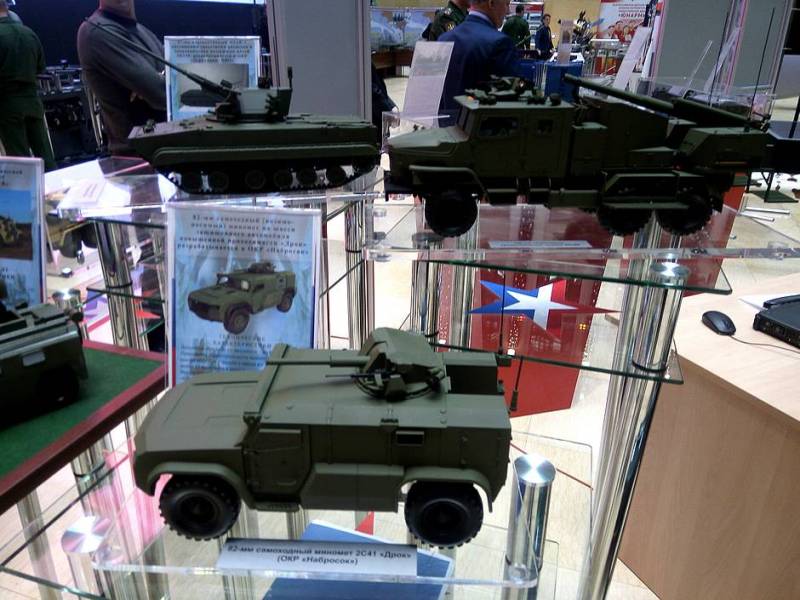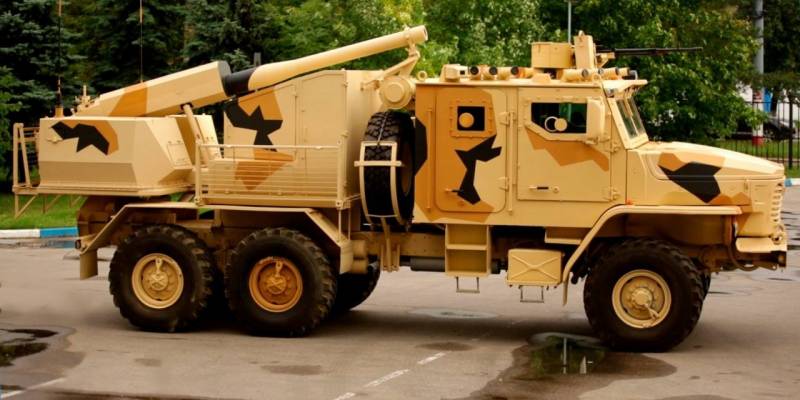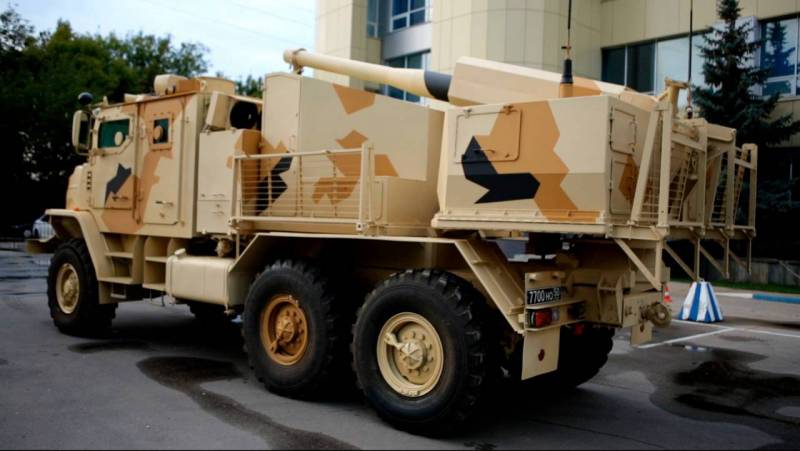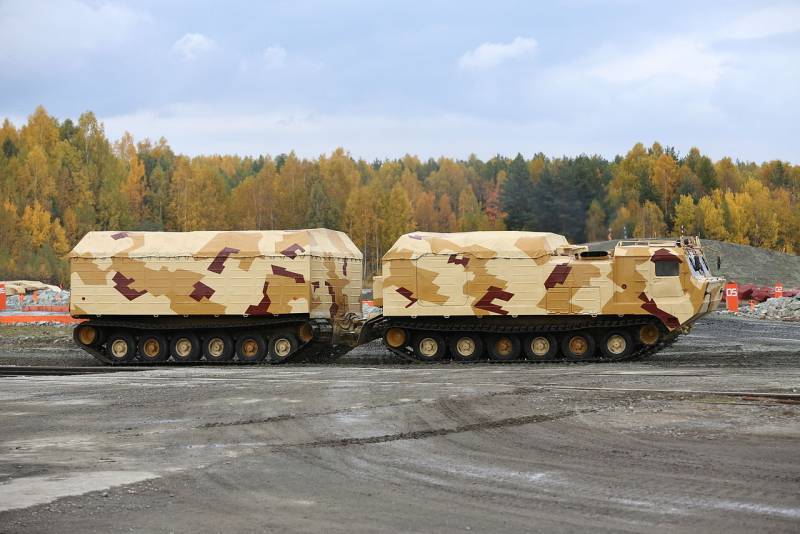Project "Sketch": three guns complete tests
New messages about the progress and results of the draft “Sketch”, as well as about the equipment of this family appeared a few days ago. It is curious that the first news was announced at the official level. 30 September, on the eve of the Day of the Ground Forces, the publication of "MK" published an interview with the commander in chief of the ground forces Colonel-General Oleg Salyukov. The commander spoke about current work and future projects. Among other things, he mentioned new developments for artillery formations.
According to the commander in chief, a promising artillery and mortar complex with the code "Sketch" is being developed. Systems from this complex are intended for use in the missile and artillery forces at the battalion level. All samples of the family are based on different chassis. Among other things, it provides for the adaptation of technology for operation in the Arctic.
October 3 new details of the project "Sketch" published an online edition of the NPK "Uralvagonzavod" T-Digest. In addition, in his message was present new information on the progress of work. According to the T-Digest, the Sketch family includes three samples of self-propelled artillery. These are the self-propelled guns "Phlox" and "Magnolia", as well as the self-propelled mortar "Drok". New "flower" systems have some common features, but at the same time they are seriously different from each other in all respects.
The development of a new family of technology led the Central Research Institute "Burevestnik" (Nizhny Novgorod), which is part of Uralvagonzavod. This company has long been engaged in the development of artillery systems, and for some time its product catalog includes three promising products at once.
T-Digest indicates that all three artillery systems are currently under test. Moreover, they are already entering the final stage of the project. Thus, in the near future, three self-propelled guns can receive a recommendation for adoption, and then go into mass production. However, the timing of the completion of the tests and the possible start of service has not yet been specified. The publication at Uralvagonzavod costs the general wording and writes “very soon”.
***
It should be noted that in recent reports we are talking about the well-known developments of the domestic industry. So, the development work "Sketch" started in 2015, and soon gave the first results. The prototype CJSC "Phlox" was first presented at the exhibition "Army-2016". The first show of the mortar “Drok” took place at the same event, although this development was demonstrated only in the form of a scale model. The third sample of the Sketch family, the Magnolia instrument, has not yet been demonstrated openly. Thus, in just the past few years, the Petrel Research Institute has created and brought to the test a promising artillery and mortar complex.
Back in 2016, some information about the goals and objectives of the projects was announced, as well as their technical details. New self-propelled guns, which, as is now known, belong to the same family, are intended for firing at enemy ground targets located at distances of up to tens of kilometers. CAO is proposed to be used when shooting from closed positions, while ensuring the possibility of hitting targets in a wide range of distances, including at minimum distances.
It was argued that the concept of a universal 120-mm gun on a wheeled chassis is being implemented in new projects. The armament already consists of the CJSC "Nona" and "Khosta" with similar weapons, but they were built on the basis of a tracked armored vehicle. It is expected that the use of wheeled chassis will allow to combine the fighting qualities of weapons and high mobility of automotive vehicles. The latter features are of particular importance because they allow to increase the survivability and combat effectiveness of self-propelled guns.
At the same time, the project "Sketch" provides for the installation of similar artillery systems on different chassis. This approach provides additional mobility benefits. Thus, the Phlox IJSC is built on a wheeled platform and is intended for use in areas with a developed road network and not the most difficult off-road. For more difficult areas, including the Arctic, created another version of self-propelled gun - "Magnolia". The presence of a floating tracked chassis gives such a combat vehicle obvious advantages.
As a result, the customer gets the opportunity to choose from several offers a car that best meets its requirements. Or there is an opportunity to distribute the equipment of several types in different regions and regions, given its capabilities and characteristics. From certain points of view, such an approach to rearmament has some advantages over the traditional construction of one machine for all needs.
***
The Sketch family includes three artillery systems. Two of them have already been shown in the form of mock-ups or full-fledged prototypes. The third has not yet been demonstrated to the public, but its approximate appearance is already known. Also, the authors of the project have already published some of the characteristics of promising technology. All this allows you to make a fairly detailed picture, in which, however, there are still white spots.
CJSC "Phlox" is a 120-mm artillery system based on a three-axle armored car. The basis of this sample is the chassis "Ural-VV", rebuilt as necessary. In front of the chassis is a double-row cabin layout, behind which are two large blocks with the necessary equipment. Directly at the stern placed rotary device with a tool. The chassis is equipped with a hp 270 diesel engine. and transmission, providing all-wheel drive.

Models of promising technology from the Petrel Research Institute. In the foreground self-propelled mortar "Drok". Photo Soyuzmash.ru
The self-propelled gun was developed on the basis of the existing 2А80 product and unified with it for a number of units. The original design was seriously reworked, which made it possible to improve the accuracy and accuracy of shooting, as well as reduce the load on the chassis. Used 120-mm barrel without rifling, equipped with a semi-automatic shutter. With it, the gun can use both standard mortar mines and artillery shells of the appropriate caliber. This expands the range of tasks and makes the "Phlox" a direct analogue of the serial "Vienna" and "Hosts." Ammunition guns consists of 80 shots. Of these, 28 are in the so-called. operational styling.
"Phlox" is completed with a modern fire control system, which includes navigation and control tools for guiding guns. An interesting innovation are the sensors that track the position of the trunk. With their help, after each shot, you can restore the tip. According to the ballistics, “Phlox” corresponds to “Vienna”, as a result of which the firing range of conventional shells reaches 8-10 km. Active-jet fly to 15-17 km.
The crew has an armored cabin that protects them from small arms. weapons and splinters. In addition, for self-defense, it is proposed to use a remote-controlled combat module with a Kord machine gun. Next to him on the roof of the cab are mounted products 902B.
The appearance of the CJSC Magnolia has not yet appeared in open sources, but certain features of this machine are already known. According to recent reports, this project involves the installation of tools from the "Flox" on another chassis. The latter is a two-link tracked carrier DT-30. Apparently, a modification with armored compartment is used, and the rear link is allocated for the installation of an artillery system.
DT-30 is equipped with a hp 710 diesel engine. and a special transmission that drives the tracks of both links. Between themselves, the two bodies of the conveyor are connected with a special assembly, including hydraulic actuators. With curb weight 28 t, the conveyor is able to carry up to 30 t cargo. The new gun type 2А80 does not have a large mass, and therefore the "Magnolia" must remain a large stock of carrying capacity. It can be used to increase ammunition or improve crew conditions.
NPK "Uralvagonzavod" and the Ministry of Defense have not yet shown the CJSC "Magnolia" to the public, however, the existence of a prototype of this type is already known. It is possible that soon the prototype will receive its share of attention.
The self-propelled mortar "Drok" also exists in the form of a prototype, but at the exhibitions so far only mock-ups of such equipment were shown. With their help, the designers clearly showed the main provisions of the project, the architecture and capabilities of the combat vehicle. First of all, it should be noted that the new mortar on a self-propelled chassis is very different from previous domestic developments in its class.
The base for "Drok" was a two-axle armored car "Typhoon Airborne", originally designed for the installation of various weapons. The new project provides for the use of a special combat module mounted on the roof. This module is a tower with mounts for an 82-mm mortar. The barrel is placed on recoil devices, but it can be removed if necessary. In this case, the mortar turns into a wearable and is used with a biped and base plate of standard types.
The “Grok” combat vehicle is designed to solve the same tasks as other mortars of all classes. The characteristics of 82-mm mines make it possible to effectively solve fire support tasks at the battalion level. According to the developer, the self-propelled gun “Drok” carries with it 40 mines and shows the rate of fire to 12 shots per minute. The firing range is from 100 m to 6 km.
***
In recent decades, the need to transfer artillery systems of all main classes to self-propelled chassis has become obvious. At the same time, the construction of ACS of traditional appearance is not always possible or advisable. All this becomes the prerequisites for the emergence of new original models of artillery equipment, significantly different from the previously created ones.
According to the reports of the last few years, the Petrel Research Institute and the Uralvagonzavod Research and Production Corporation under the Sketch project managed to create three versions of self-propelled guns at once, distinguished by comparative simplicity with sufficiently high combat characteristics. In addition, they have good mobility, contributing to increased vitality. In this case, two samples of the three, being equipped with special tools, are able to perform the functions of guns, howitzers and mortars.
Previously, the components of the new artillery-mortar complex appeared only at exhibitions, but by now projects have advanced far ahead. According to recent reports, the Phlox, Magnolia and Drock have already entered state trials and are nearing completion. After all the necessary checks, new vehicles can enter into service with ground or airborne troops.
On the materials of the sites:
https://mk.ru/
http://t-digest.ru/
https://rg.ru/
http://tass.ru/
https://tvzvezda.ru/
https://bmpd.livejournal.com/



Information